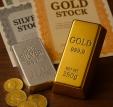Wall Street bets on gains for gold next week, Main Street maintains a more cautious stance as rate decisions loom
NEW YORK (June 13) Gold appeared content to trade in a narrow range this week, relatively unmoved by positive inflation data—until renewed conflict in the Middle East drove safe-haven demand once again.
Spot gold kicked off the week trading at $3,317.32 per ounce, and apart from a brief dip down to test support at $3,296 around 10:00 p.m. Sunday evening, the precious metal never really challenged the $3,300 floor again.
In fact, gold didn't look prepared to challenge any ceilings this week either, as the yellow metal traded in a $50 range – but mostly between $3,320 and $3,345 – until Wednesday afternoon, when the first inklings that something big might be brewing in the Middle East began to roil markets.
Spot gold quickly rose from $3,324 per ounce at 1:45 p.m. EDT to a fresh weekly high of $3,377 by 10:30 p.m., and after a pullback to test previous resistance near $3,345, it ultimately topped out just a dollar shy of $3,400 at the North American market open on Thursday.
By now, markets were very much on edge, and the yellow metal wouldn't fall below $3,380 until news of Israel's attacks on Iran hit the wires around 7:30 p.m., whereupon gold prices shot all the way up above $3,440 per ounce just before 11:00 p.m. EDT.
Once it became clear that Iran's initial response would fall flat, gold prices retreated to test initial support near $3,414 per ounce, and after another run at resistance near $3446 per ounce failed at the North American open, traders were content to allow spot gold to bounce between $3,420 and $3,435 for the duration of the session.

The latest Kitco News Weekly Gold Survey showed industry experts firmly bullish on gold’s prospects, while it was retail traders’ turn to pull back a bit despite gold’s solid gains.
“Higher,” said Rich Checkan, president and COO of Asset Strategies International. “With the Israeli attack on Iran heating tensions up across the globe, there is no doubt where gold is going next week.”
“Up,” said Darin Newsom, senior market analyst at Barchart.com. “A civil war growing in the US. Missiles flying in the Middle East. The rest of the world selling the US dollar. The FOMC expected to hold rates unchanged next week – if there is a meeting. Or even a next week. Those tanks rolling down Pennsylvania Avenue over the weekend could change things.”
Daniel Pavilonis, senior commodities broker at RJO Futures, was looking at the performances of both oil and gold during previous Mideast flare-ups for indications on where the commodities might be headed.
“I think we can use oil as some somewhat of an indication of what was going on with gold last night,” he said. “Both of them are inflationary hedges, and both of them are tied to yields. But the thing is, oil spiked up to $77 at the same time that gold spiked to its highs last night, and then we sold off similar to oil, we went up to $77.62, and then we sold off all the way down to $70. It was right around the time when Iran retaliated, and then it was like, ‘Okay, nothing happened. Now, what's going to happen going forward?’”
“I think it’s pretty surprising that gold is still below the highs from April.”
Pavilonis said that if we do see further escalation, gold could continue to move higher. “But if we start to see the situation weaken –Iran comes to the table and at least starts to negotiate in some form – maybe gold just stays elevated and sideways up here, maybe we see a continuation of what we've seen over the last couple of months. We haven't broken through the highs, and I think it would take further escalation to do that.”
Pavilonis said the biggest recent driver for gold has been geopolitics, but the price gains on the back of conflict have been short-lived.
“We saw the same thing happen in April of last year with gold [and oil],” he said. “We spiked up and then sold off after that. But tariffs and things were still there, there was still this unease with China trade, and inflation has dropped dramatically. We passed all these different hurdles. A lot of the things that were driving gold after that wave were slowing down since April's high. And now this is just another thing to drive it higher geopolitically.”
“I think if this starts to lose steam, maybe this is a double top in gold,” Pavilonis added. “We're not quite there yet, we're within the wick from April 22. I think that's where we're at right now, so in order to drive this thing above $3,509, $3,510, I think we need some more Middle East unease. If that escalates, I think we can drive higher, but other than that, I don't know, maybe we peak through the highs and sell off after that. I don't know what's going to drive it a lot higher.”
“This is a time where, if you missed the boat to take some profit at $3,509, you probably want to start looking at taking something off the table here,” he advised. “We see this in the crypto markets, like the alt season transition, where gold is topping out, and then you start to see all these other markets move higher, like silver, platinum, and palladium. I think you may start to see something like that.”
“If we look at where gold is and where silver should be, we should probably be at like $50 an ounce,” he added. “You can buy a lot more silver with one ounce of gold. I think people are looking at that, and really considering how silver has behaved in the past, and seeing an opportunity there.”
This week, 14 analysts participated in the Kitco News Gold Survey, with Wall Street reaffirming its bullish bias after this week’s cooling inflation data and incendiary Middle East developments. 10 experts, or 71%, expected to see gold prices rise during the week ahead, while only one analyst, or 7%, predicted a price decline for the yellow metal. The remaining three analysts, representing 21% of the total, saw gold trading sideways next week.
Meanwhile, 253 votes were cast in Kitco’s online poll, with Main Street showing an uncharacteristically more bearish stance on gold compared to the experts’ opinions. 146 retail traders, or 58%, looked for gold prices to rise next week, while 54, or 21%, expected the yellow metal to slide lower. The remaining 53 investors, or 21%, saw prices consolidating during the week ahead.

After a week focused on inflation data, next week will revolve around central bank rate decisions and signals of future monetary policy moves.
Monday will see the release of the Empire State Manufacturing Survey, followed by the first central bank rate announcement from the Bank of Japan in the evening. Then on Tuesday, traders will look at U.S. Retail Sales numbers for May for signs of weakening consumer spending.
Wednesday brings the U.S. Federal Reserve’s monetary policy announcement, with markets priced in for a hold but eager to see if Chair Jerome Powell lays the groundwork for future rate cuts. Markets will also pay attention to May housing starts, along with the early release of weekly jobless claims.
U.S. markets will be closed on Thursday for the Juneteenth holiday, but the Swiss National Bank and Bank of England will both deliver their monetary policy decisions. And the week will conclude with the Philly Fed Manufacturing Survey on Friday.
Marc Chandler, managing director at Bannockburn Global Forex, said he expects gold to resume its uptrend and challenge the April highs.
“Given the geopolitical developments, gold’s role as a safe haven has been underscored in a more impressive way than the dollar or Treasuries and crypto,” he said. “After the recent pullback, the yellow metal looks set to re-challenge the record high near $3500. The heightened geopolitical uncertainty is likely to persist beyond next week.”
“The FOMC, BOE, and BOJ meet next week,” Chandler added. “None are expected to do anything, but the SNB will likely cut its deposit rate to zero, and its two-year yield is already negative. This may also be supportive for gold.”
Adrian Day, president of Adrian Day Asset Management, told Kitco News it was important to differentiate between the stable and longer-term drivers of the gold rally and the short-term geopolitical spikes.
“I look at the main factors that have driven gold this year and over the last three years,” he said. “Central bank buying to diversify assets away from the dollar in the face of dollar weaponization, Chinese non-official buying in the face of concern about a yuan devaluation in the middle of a slowing economy, and obviously not wanting to buy real estate and not allowed to buy crypto, so gold is the obvious place for them. And then also wealthy individuals and families concerned about the global fiscal situation, the amounts of debt, and so on.”
“I think those are the main drivers, and none of that has changed,” he said. “And none of that is likely to change in the near term. Central bank buying may slow down. The aggregate holdings in the U.S. dollar among all central banks’ foreign reserves is now just under 50%, so it's come down dramatically over the last few years, and also over the last 25 years, frankly. But again, that's the aggregates. If you look at some of the faster-growing Asian countries, they have significantly more in the dollar, significantly less in gold, so on balance, I think the buying will continue.”
“The North American investor, however, will typically buy gold as an investment based on economic factors. “And those have only just started to shift in gold’s favor,” Day said. “Up until recently, the narrative has been a strong economy, high interest rates, low inflation, and a reasonably strong dollar. That's precisely the wrong environment to be looking for gold.”
“The economic narrative in the U.S. has started to shift a little bit more negative; that's positive for gold,” he said. “The dollar has been a little weaker – until obviously the last 24 hours – that's positive for gold. So the North American investor has only just started to get in on that.”
Day said that based on his research of gold’s behavior during previous conflicts, there are two key factors that determine whether or not the yellow metal makes a sustained move higher.
“The main factors are A, whether gold is already in a bull market, and B, whether there's a sense that this could continue to escalate,” he said. “If it’s seen as a one-off, it doesn't have much impact. Iraq's invasion of Kuwait and the subsequent US invasion didn't really have much impact on gold. 9/11 had a pretty short-term impact on gold. It really seems to depend on whether people think things are going to spiral out of control.”
For the next move higher, Day is looking instead to speculative and safe-haven flows from the United States in particular.
“The North American investor, particularly the U.S. investor, has only just begun to dip their toes into this. You look at the flows into the GDX, we're talking gold stocks now, GDX and GDXJ. GDXJ, its first inflows since last August, were last week, which is astonishing. And the GDX, even though over the last month, since the middle of May, we've had more days of inflows than outflows on a one-month basis, there's still net outflows from the GDX. Up until the middle of May, there were only three days this year of any net inflows into GDX, and no days of net inflows on GDXJ, so the fact that we're seeing anything coming in is really quite a turn.”
“The other signs I would point to are that the juniors have been outperforming the seniors, and that silver has been outperforming gold,” he added. “Those are both clearly indications of retail interest coming into the sector.”
And while Day still sees the market as potentially overbought at these elevated levels, it has continued to perform.
“I've been saying there's a risk of a pullback for the last 18 months, and that hasn't gotten me very far,” he said. “Gold has just been remarkably resilient, which suggests there are a lot of people waiting to jump in, people who feel underweight. And again, if you look at central banks that are concerned about dollar weaponization, why would you stop at 60% dollars or 50% dollars if you are worried that your dollars might be stolen? Maybe you want to go down to zero, or at least you want to go lower than you are.”
“Every pullback or pause has been met very soon by a wave of new buying.”
“Up, said Alex Kuptsikevich, senior market analyst at FxPro. “The insatiable appetite of central banks has resulted in an increase in the share of gold value in reserves to 20%. Precious metals have surpassed the euro's 16% share. Only the US dollar is ahead with 46%. In 2022-2024, regulators increased their purchases to more than 1,000 tonnes annually. As a result, their combined gold reserves grew to 36,000 tonnes by the end of last year. They are now very close to the record set in 1965 of 38,000 tonnes.”
“The weakening of the US dollar and falling Treasury yields support the gold price,” he said. “The reluctance of US inflation to accelerate under the influence of tariffs and the cooling of the economy increases the risks of resuming the Fed's monetary expansion cycle as early as September. Until recently, the futures market has not been pricing a rate cut until October.”
Kuptsikevich added that geopolitical events are also supporting the precious metal. “Gold is a safe-haven asset and proved with its performance last night,” he said. “Demand for it is growing as the risks of a new conflict in the Middle East increase. The future fate of the precious metal will depend on the resistance test at $3,400 per ounce.”
Analysts at CPM Group have issued a buy recommendation for gold, with an initial target price of $3,500 by June 20.
“Gold prices rose to CPM’s previous target over the past two days,” they wrote. “Prices began rising Thursday on economic and political concerns, and then shot sharply higher overnight and this morning after the Israel attack on Iran.”
“There continues to be a great deal of volatility in the underlying political and economic factors that trigger investor demand for gold and silver,” the analysts said. “This is being reflected in gold and silver prices. Given the volatility, CPM is shortening for now the Timeframe of its Gold Trade Recommendation to one week from a more typical two weeks.”
“Given the state of political and economic conditions, and the unlikelihood of any improvements or reductions in risks over the next week (and longer term), CPM is maintaining its Buy recommendation for gold,” they added. “Prices seem most likely to continue to rise on investor buying, and may test $3,500 in the coming week. Prices could reach $3,600 between now and September. How high prices go and if prices retreat will depend on the political and economic developments.”
“It seems increasingly unlikely gold will fall sharply below $3,200, or maybe $3,000, during the next few months,” the analysts said. “CPM has had as its main outlook has been for a seasonal summer pause in gold and silver prices with the proviso that such could easily be overridden by more hostile political and economic developments. This is what appears to be happening. In addition, there are the ongoing trade and tariffs issues with very little actually firmly fully resolved as of today.”
And Kitco Senior Analyst Jim Wyckoff believes gold will see no shortage of buyers next week. “Higher on bullish technical and keener risk aversion in the general marketplace that will prompt better safe-haven demand.”
KitcoNews










